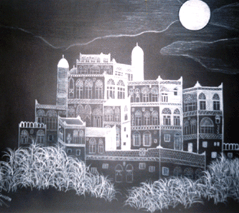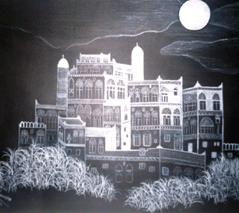
Two successful women show their paintings Yemen’s spirit captured in art [Archives:2003/09/Culture]
February 3 2003
BY ABDUH M. ASSABRI
YEMEN TIMES STAFF
[email protected]

Further, it can be understood by all people in the world. Artists have a distinguished outlook to express the meaning of life.
This is why the world has given this kind of art a wide scope. It is an influx of deep emotional feelings, a portrait through which the artist can express his inner feelings. They can embody these emotions in drawings which can be either real or imaginary
Among those talented artists is Maisoon Hussein Bin Yahya.
She was born in Sana’a in 1978 and at present she is a demonstrator at the University of Science & Technology.
She is a dentistry technician.
She inclined to paintings when she was young, specifically when she was in preparatory school.
Her portraits were at first seen by her parents and therefore they spur her on to continue on that art.
Little by little, she could shape her creativity and capability in paintings.
She also could form a new style of her own and select other color technicalities where no other artist can do so.
Bint Yahya’s main contributions
– Egypt In Others’ Eyes’, Cairo, 1999.
– First place in the RAINBOW’ Competition, Hungary, 1996.
– Golden Medal and a Diploma in the Plastic Art, Hungary, 1996.
– Participated in the President’s Prize, Sana’a, 2000.
– Held exhibition at the headquarters of the Yemeni Writers & Authors Union, Sana’a, 2001.
Bint Yahya’s first art exhibition was at the Yemeni Writer’s and Authors Union. “It was a very simple exhibition. To me, it was also a humble beginning,” Maisoon said.
At first sight, when a viewer have a look on Maisoon’s paintings, he could see that a black background is the most prevailing factor on her paintings. Why so that?
“My selection for the black color is my own. Therefore people see that the black color conveys sad and depressing atmosphere. It is true that I used the black color in most of my paintings, but this doesn’t mean that they convey a sad atmosphere. Despite that my paintings have a black background, multi-colored paintings and beautiful natural scenes are there also,” she explained.
“I want to use the black color as a special style in my paintings and I hope could succeed in that,” she added.
Does this mean that the black color is an indication to woman’s reality in the Yemen?
“I never use the black color for that reason,” she said.
“It is true that women are symbolized with the black color in a “A Yemeni Woman”, But I incorporate other natural scenes such as, sea and landscapes,” Maisoon further commented.
The art in Yemen has occupied the minds of the concerned bodies at the culture Ministry. This has come, when preparations are in full swing to announce Sana’a as the Cultural Capital for 2004.
Maisoon’s assessment to the reality of the art in Yemen before a couple of years ago was that no interest was showed at all.
It was simple and restricted only to schools.
Maisoon’s first participation was in Hungary through an invitation to Arwa School.
She only participated in three paintings. After her entering class at the University, an interest to the plastic art was felt at simple institutions. There was a high attendance to such exhibition.
When asked that women are more attracted to such wind of art more than men. “I am totally against this,” she disagreed.
Art is that kind which entails sensitivity and transparency by both men and women. “Women seem to be more romantic, and this could be reflected upon her paintings, which are by no means, tranquil and calm,” she said.
“When I started painting, I always do my best to reveal the beautiful picture of the Yemeni architecture,” she added.
Maisoon’s paintings “The Moon of Sana’a”, she selects the white and black colors. Moon with its lights has added a special effect upon the Yemeni original architecture. This new style of painting is invented by her in contrary to other artists where their paintings are confined only to show this kind of art as it is.
In the “Sadness of Women”, women appear to be clothed with black gowns and their facial expressions haven’t been showed.
The portrait includes jars beside women’s gowns which is an indication of their suppression. They are treated as workers.
“I intentionally paint their gown with black without any facial expressions,”, she noted.
“At the end, I thank those who give their hands and making tremendous success of this exhibition, such as, Abdulrahman al-Akwa Khaled al-Rowaishan, Zaid al-Faqeeh and others,” she concluded.
Aamal Ahmed al-Qadhi, born in Sana’a in 1979, studied Faculty of Commerce, Accounting Department, Sana’a University.
al-Qadhi’s main contributions
– A workshop titled, ‘Art & Heritage’ supported by the DIA organization, Sana’a 2001.
– A workshop titled, ‘Health & Environment’ also supported by the DIA organization, Sana’a, 2001.
– Got the second in the Cultural Competition in the plastic art, Sana’a University, 2002.
– Participated in an exhibition at the Faculty of Commerce & Industry.
– A member at Ebhar Foundation for Childhood & Creativity.
Al-Qadhi’s humble beginnings in paintings have risen and she is now ranked as one of the best well-known female artists in Yemen.
She was at first dissatisfied with her first painting, she didn’t lose hope, because she was fully convinced that it still had had a meaningful content.
As a budding talent she was inclined to the blue color, but with the passage of time, a tendency began to shape itself within herself and could use all colors.
Al-Qadhi has been greatly influenced by Maisoon’s paintings. She always shows her paintings to Maisoon and at length they decided to hold a joint plastic art exhibition.
There is a considerable increase by women towards the plastic art in Yemen.
Al-Qadhi like Maisoon share the same ideas in that the plastic art in Yemen was different from that of today. That is because of people have become more aware and more extrovert.
Al-Qadhi has a number of portraits such as ‘Tafreta’ i.e.. to spend time together with women chatting, laughing, and chewing Qat.
“In this, portrait, I was on a holiday in Sana’a and by chance,I saw a woman, I took a photograph for her. What attracted my attention was the cloth she covered herself with,” Al-Qadhi said further.
‘Flutist’ is another portrait loved by Al-Qadhi and ‘ A Terrified World’ where she sees faces and feels that each one has a world of his own.
“Seydana” is another portrait of a person. It used to be called by Al-Qadhi as “Uncle Saleh” and later on it was named Seydana by her father.
Al-Qadhi sees that restoring to painting sometimes is a relief of suppression or subduing inner feelings.
“When a man is for instance angry, frustrated or when something freighting, worrying or painful occurs, I restore to paintings and it is a comfort. Even I draw a simple one,” Al-Qadhi noted.
“At the end, I’d like to thank the Culture House represented by Khaled al-Rowishan, and Zaid al-Faqeeh for making success in the exhibition,” she concluded.
Now new artists are promising of better times to come. Now we witness more exhibitions organized in schools, universities and cultural centers.
There is a criticism movement in newspapers, magazines, writings and TVs, etc. Media can help improve the understanding of people to art.
I advise new artists to go on painting and there will be one day when people would understand the meaning of art and how important it is for the society.
——
[archive-e:09-v:2003-y:2003-d:2003-02-03-p:./2003/iss09/culture.htm]


